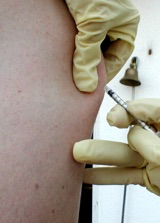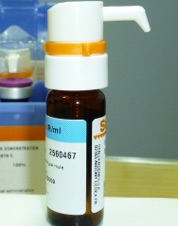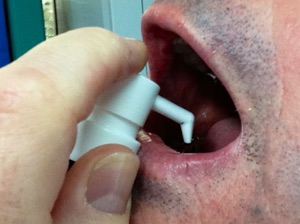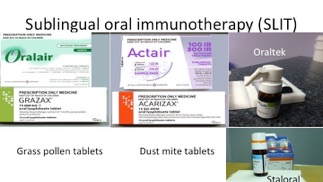Allergen immunotherapy

IMPORTANT The information provided is of a general nature and should not be used as a substitute for professional advice. If you think you may suffer from an allergic or other disease that requires attention, you should discuss it with your family doctor. The content of the information articles and all illustrations on this website remains the intellectual property of Dr Raymond Mullins and cannot be reproduced without written permission.
What is immunotherapy?
The aim of immunotherapy is to switch off the allergic response. By giving doses of commercially prepared extracts of substances that a person is allergic to, the immune response to allergen gradually decreases over time. It is the closest thing to natural therapy since medication only suppresses the symptoms, not the underlying immune response.
If this like homeopathy?
No. The concept of homeopathy is that weaker and weaker dilutions of extracts are more effective than stronger ones. By contrast, response to immunotherapy is – responsive – small doses don’t work but big doses are more likely to.
What conditions is it used for?
Dangerous insect sting reactions/anaphylaxis – routinely recommended
Large local swellings in response to insect stings – not normally recommended as these only occasionally ever get worse.
Insect bite and tick bite reactions – no vaccines are available for treatment of these.
Hay fever and allergic asthma – commonly used when people wish to control their symptoms with less medication.
Eczema/dermatitis – not routinely recommended because the jury is out as to whether this actually works well or not. There are small published trials only showing conflicting evidence of benefit.
Food allergy – this is not considered to be a routine treatment for food allergy, but rather one still in the research basket. A high proportion of those doing oral immunotherapy have regular side-effects, and can have unpredictable allergic reactions to food eaten. Food patches have been studied, but none are registered at this time. Currently therefore, food immunotherapy is not recommended in Australia or New Zealand outside of research studies. An ASCIA statement on this topic can be found at: https://www.allergy.org.au/patients/allergy-treatment/oral-immunotherapy-for-food-allergy
Why consider immunotherapy?
The trigger is hard to avoid
Medication – doesn’t work, causes side-effects or you dislike the idea of using medication
Cost – in those with severe allergic disease, immunotherapy is less expensive than taking drugs for decades.
Lifestyle or occupation – for example, people who can’t avoid pets or don’t want to avoid pets or who would like to purchase a pet yet are allergic to them.
Asthma prevention – as well as treating the allergic component of asthma, there are increasing number of studies demonstrating that early treatment of hay fever can reduce the risk of allergic asthma development as well.
More options are available than years ago
1.“Routine” immunotherapy injections – these have been around since the 1950s and involve weekly injections for a few months and eventually once per month all year round for 3 to 5 years. A 30 minute wait after each injection is required for safety reasons in case an allergic reaction occurs, such as rash or difficulty breathing or dizziness. Best practice is separating different types of extracts, for example dust mite in one injection and grasses in another. That generates potentially more than one extract and therefore a higher cost.
2.Allergoid injections – these are treated so that allergic reactions are less likely to occur as side-effects. The risk of serious side-effects is considered to much less likely to occur then routine injections. For this reason, only one undertakes weekly injections for a couple of weeks only and then once per month. Mixing of extracts is also possible as the enzymes in one extract are unlikely to break down other allergen extracts in the same bottle. They can make it cheaper and safer, but there is still a 30 minute wait after each injection.
3.Oral liquid – oral liquid extracts have been available in Australia since around 2007. They are taken most days all year round. Many patients benefit but my impression is they are not as effective as new oral allergen tablets and they are just as expensive.
4.Oral tablets – grass tablets have been available on the Australian market since 2013 and dust mite tablets since 2017. Published studies show these to be very effective, although they are more expensive than injections usually. They are fully registered and one purchases them on prescription from a phamacy.There are also cat and other allergen extracts available as well from smaller pharmaceutical companies.
Oral treatment is clearly more attractive in young children but injections are still possible in children if one uses a numbing EMLA patch applied to the injection site 1 hour before.
Safety aspects
After injections, there is a 30 minute wait period for safety reasons after each and every injection. With oral tablets, there is a 30 minute wait after the first dose in case tongue or throat swelling occurs, but after that, doses are taken at home. Oral liquids are considered to be very safe and therefore only a brief wait period after the first dose is needed with other doses taken at home. Antihistamines can be taken before each and every injection to reduce side-effects, and I routinely recommend those on tablet immunotherapy, take antihistamines every day for the first fortnight of treatment for the same reason.
Risks and side-effects of injections
*Common ~ 50%: Everyone gets an itchy lump at the site of injection of variable size. You can take an antihistamine after or before the injection to reduce the discomfort. I recommend this as a routine.
*Uncommon ~ 5-10%: Large local itch and swelling. If you get large local reactions, your doctor may temporarily reduce the dose.
*Rare ~ 1%: More serious side-effects can also occur after an injection. These are most common in the first few months of treatment, but can occur at any time. Most side-effects occur within 30 minutes of an injection. A waiting period is compulsory so that you will be close to your treating doctor if there is a problem. It is also wise to avoid exercise for ~3 hours on either side of your injection (some doctors recommend not exercising the rest of the day). If you play sport, have the injection on another day or if you work in a physical job, have the injection at the end of the day.
Serious side-effects can include:
•Rash (hives) all over, throat/tongue swelling
•Hay fever-like symptoms
•Wheeze/asthma-like symptoms
•Dizziness, drop in blood pressure or shock
•Flu’-like symptoms a day or two later
Improving injection safety
•Take an antihistamine before every injection (preferably a few hours before or the night before if you have morning injections)
•Wait 30 minutes after each injection (this is compulsory)
•Do not exercise or play sport or have hot saunas/baths within 3 hours of an injection
Risk and side-effects of oral treatment
Common: Unpleasant taste with liquids although this varies between brands. Children can suck a lollie at the same time. ~ 20 %: Irritation or itching inside the mouth and throat. These can be helped by temporarily reducing the dose or talking an antihistamine beforehand. E.g. the night before. Tablets have no significant taste at all.
*Uncommon: ~ 3-5% Stomach upset, nausea, chest pain, stomach pain, trouble swallowing
*Rare: The risk of potentially dangerous side-effects such as difficulty breathing or rashes is considered to be very uncommon but the tablets are much more potent products so local side-effects are much more likely.
NOTE: the oral tablets are more potent products more likely to work, and more likely to cause side-effects.
Is immunotherapy subsidised on the PBS or Medicare?
Medical visits are subsidised but no allergen extract is eligible for a rebate under Medicare Australia.
Is it possible to obtain private health refunds for immunotherapy?
There are no fully registered injectable extracts that one can currently purchase in Australia. That may change in the future. At the moment, therefore, a rebate is unlikely.
Allergoid injections are imported and licensed for single patient use and are not fully registered and therefore it is unlikely you will obtain any refund from your health fund.
Oral liquids like Staloral or Oraltek are unlikely generate any private health refund.
Fully registered tablets in Australia may be eligible for rebates from private health funds if a person has the right health fund cover. If asking about tablets, would need to ask the health fund whether they give money back grass tablets like Oralair or Grazax or dust mite tablets like Acarizax or Actair which are fully registered in Australia.
What is better: tablets or injections?
This is a sensible and very good question, but one that is not that easy to answer. Most of the injection trials are older studies but compare active injections vs dummy placebo. The tablet studies are much the same, comparing active to dummy/placebo tablet. There are only as handful of studies comparing tablets and injections in the same research study and these are too small (~ 20-30 subjects) to show any meaningful difference. If I have patients on tablets and they do well, I continue them for another few years. If they do not do well, then some do better if switched to injections. I have also had the opposite observation; people doing very well on tablets but switch to injections to save money and they do worse than on the tablets. So some seem to do better on one treatment than another and it is not possible to predict who. On the other hand, it is useful to be aware that the BEST evidence of benefit from immunotherapy are from the recent well-designed and large placebo-controlled trials of grass and dust mite tablets, which is why these drugs are fully registered in Australia. Furthermore, dust mite tablets have been shown to be of benefit when specifically studied for the treatment of allergic asthma, as opposed to most trials that examine hay fever benefit first with asthma as an afterthought.
Review appointments and duration of treatment
If one undertakes immunotherapy for only 12 months, it often returns fairly quickly. Standard recommendations are for a minimum of three years and published studies show that the vast majority of individuals who do so, remain well for at least three years after stopping, with anecdotal evidence suggesting a much longer duration of benefit. Normally therefore organises specialist review at an appropriate interval after starting treatment to assess benefit and side effects and plan for the future. The average time recommended is after 6 months of treatment, and sometimes repeats visits at later times depending on progress.
How much does immunotherapy cost?
There are a couple of brands on the Australian market and cost will be determined by the brand used, the number of allergen bottles and their concentration and whether these are mixed in the same bottle (and therefore diluted) and whether one needs to purchase one extract or more than one extract. Assuming a person is having regular treatment all year round, a rough estimate can be:
Routine injectable extracts – roughly $500 per year each.
Allergoid injectable extracts – between $400 and 800/year each.
Grass pollen tablets – around $700 per year, depending on whether one purchases these in small monthly boxes (more expensive) or three monthly boxes (much less expensive) on prescription.
Dust mite tablets – $100 per month or $1200 per year on prescription.
Cat tablets – $1200 per year
Birch tree tablets – around $700 per year
Sometimes it can be cheaper, for example in a person who has a relatively short grass pollen, hay fever season lasting a few months. Under those circumstances, so-called preseasonal immunotherapy injections taken for 3 to 4 months during winter and stopped in early springtime, can be roughly half the injection cost listed above.
When deciding on immunotherapy, cost can be influenced if there are any out-of-pocket costs for medical administration and supervision of injections. Need to check with your GP.
While immunotherapy is not cheap, routine blood pressure or cholesterol tablets can cost $40 per month unsubsidised, and a person with bad hay fever or allergic asthma taking multiple drugs all year round can easily spend $1000 per year for decades.
Making a decision about starting immunotherapy
1.Yes or no? If no, try to avoid the cause and take medication.
2.If yes, what you want to target? Dust mite only, grasses as well, pets? Don’t forget, targeting more triggers may add to the expense.
-
3.Once you have decided that, you then decide on the method – injections, oral liquids or oral tablets
BUT does it always work?
There is no treatment that is 100% effective in 100% of individuals. My estimate is that 2/3 to 3/4 do well for 2/3 to 3/4 of their symptoms. Improvement is often seen at the 6 month mark but stidies of tablets and injections show greater improvement in the 2nd and third year of therapy. If there is no improvement, one can continue longer and hope for grater befeit with longer time on treatment, or consider changing method of immunotherapy.
Last reviewed 18 November 2022




